One of the most iconic and popular open slide guitar tunings, the open E tuning has a lot to offer. Still similar to its standard guitar tuning counterpart on a few strings, yet employing the use of a major chord in the open position, the tuning is great for rock, blues, country, and other musical styles.
Achieving modern notoriety through the hands of players like Duane Allman and Derek Trucks, the tuning has proved its versatility and has the ability to shape sound in expressive ways. Let’s take a deeper look at using this tuning for slide guitar…
Tuning
Like a few other open tunings, the open E tuning takes advantage of having a major chord on its higher strings, and the root and perfect fifths of this chord as bass notes. The lowest strings, strings 6 through 4, provide a solid foundation for voicing low end notes, and strings 4 through 1 are a great vehicle for melodic and chordal options.
The two highest strings of the tuning (as well as the lowest string) are identical to the standard tuning’s strings, giving guitar players an advantage in finding their way around the neck. The fact that the tuning shares this resemblance makes it easier to quickly locate familiar positions on the neck, however some adjustments will need to be made to scale applications and harmonic patterns to accommodate strings 5 through 3.

Approaching the tuning with a fresh perspective, since it offers different avenues of playing because its an open tuning, will be a beneficial way to use it for slide guitar. However, locating positions and identifying musical patterns can become simpler if previous knowledge of the standard tuning is applied.
Here’s the tuning for open E slide guitar…
String 1 – E
String 2 – B
String 3 – G#
String 4 – E
String 5 – B
String 6 – E
The diagram below visually displays the tuning on the fretboard of the guitar:
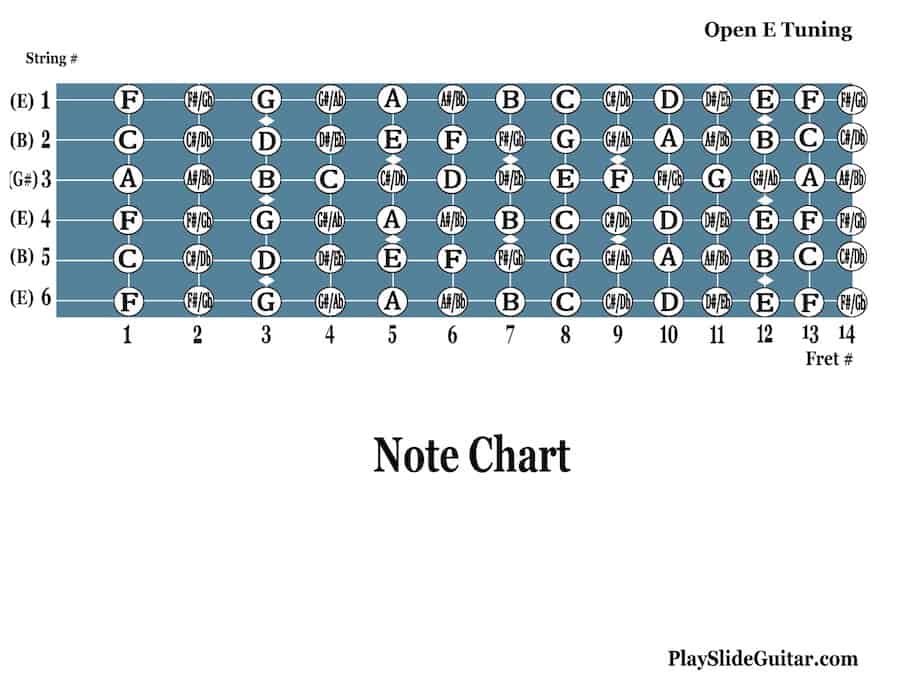
Melodic Opportunities
Slide guitar can have such emotive and vocal-like qualities, that taking advantage of the higher strings’ timbre can have a great effect on listeners.
By voicing notes on strings 2 and 1 of this tuning, especially at the 7th fret or higher, the sound can really project and provide an impactful melodic effect. These types of notes will cut through the band’s sound with presence and clarity, and provide a timbre that slide guitar is known for.
Strings 4 and 3 also offer good melodic options, and are certainly worth taking the time to study when learning the tuning. Although this is beneficial and recommended for every string, finding pockets and patterns on the fretboard that begin on the 4th and 3rd strings will really begin to unveil the tuning.
If you already have a solid understanding of strings 2 and 1 from standard guitar, then learning strings 4 and 3 and incorporating them with strings 2 and 1 becomes a simpler process. Once this is done, most of the tuning is familiar and you have begun to utilize the major chord that the open E tuning offers on strings 4 through 1.
Bass Options
The open E tuning’s lower strings can act more rhythmically and provide good bass and harmonic options for your playing, especially if you are playing slide unaccompanied. String 6 is identical to a standard guitar’s E note, and string 5 is a B note, which is a perfect 5th above the E.
Without diving too deep into theory and technical terms, these two strings give you great options for playing a steady bass line and using your slide to voice the melody of a song when you’re playing solo bottleneck guitar.
Strings 6 and 4 are the same note, with an octave difference, thus making the tuning even more straightforward and intuitive. If you can become adept at playing strings 6 through 4, then you’ve gone a long way with this tuning: you can combine these strings in your playing with all that strings 4 through 1 offer.
Check out the tabs below, which show some options for creating a steady bass line on the open E tuning…
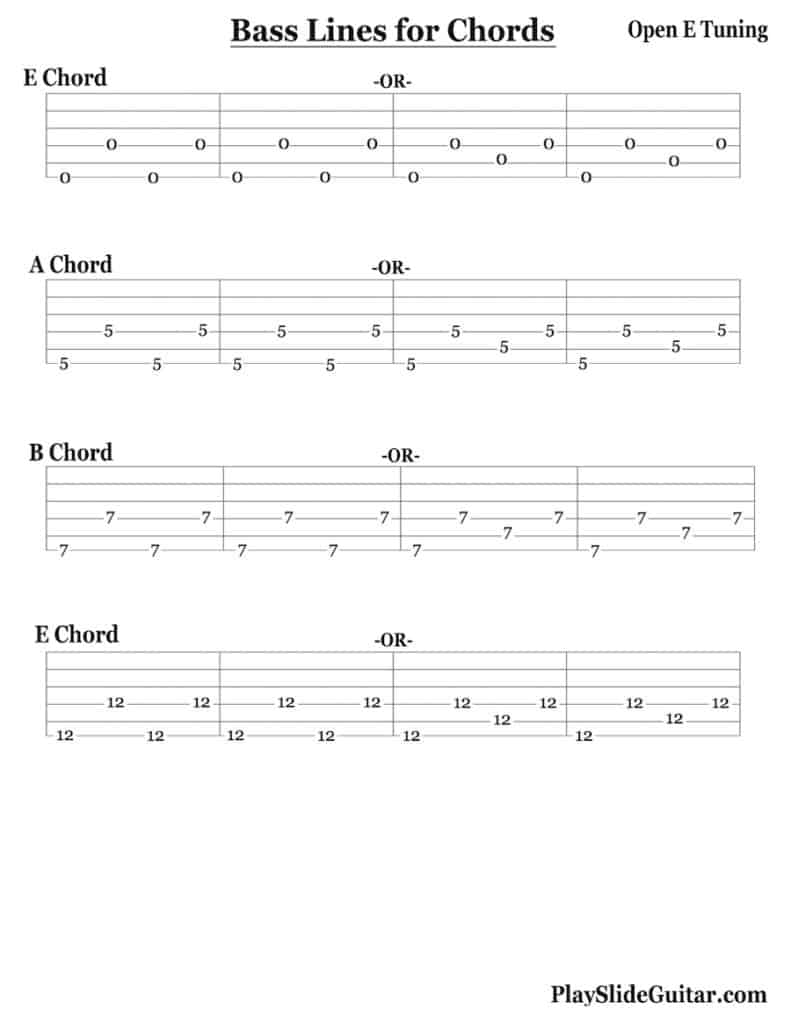
Creating Major Chords
Since this tuning revolves around a major chord, creating and voicing major chords on the tuning is intuitive and efficient. Oftentimes with this tuning, just locating the fret that corresponds with the chord for E tunings in general (i.e. playing a G major bar chord at the 3rd fret on a standard tuning guitar) will be a quick way to find major chords.
Since the open E tuning is naturally a major chord, strumming or playing any of the strings in any position will yield a full and warm sounding major chord. These positions are also great for riffs and solos, as they provide melodic options for playing over that chord.
Here’s a chart that displays many major chords along the fretboard for the open E tuning:
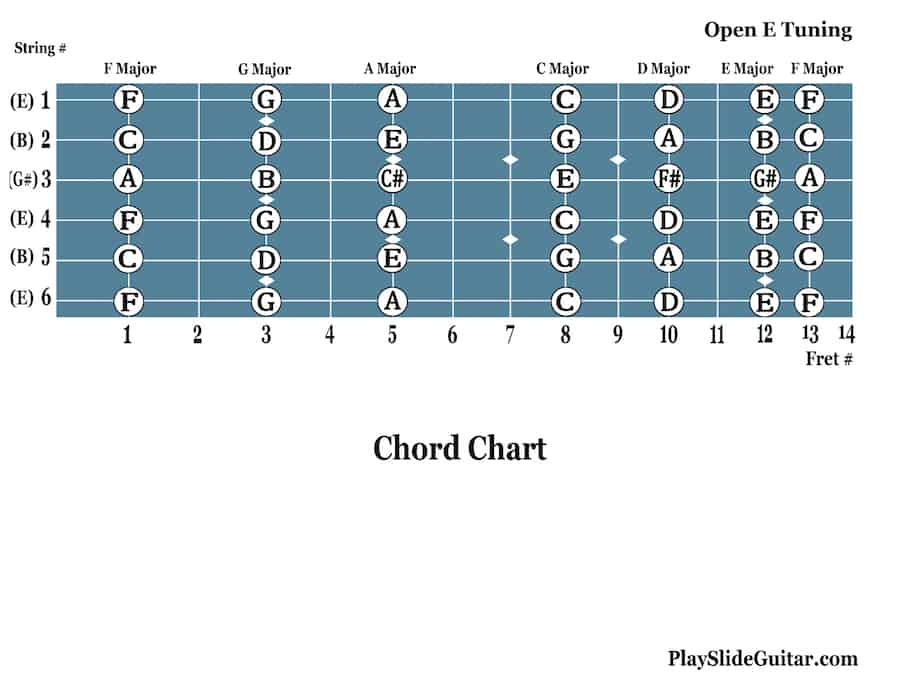
Major Chords for the Open E Tuning
The following major chords are beneficial when playing in the key of E, but their patterns are great to learn for many rock, blues, and country tunes. The number system is shown alongside the chord names, so that these relative patterns can be applied to keys other than E major as well.
E Major Chords (The 1 Chord in the Key of E Major)
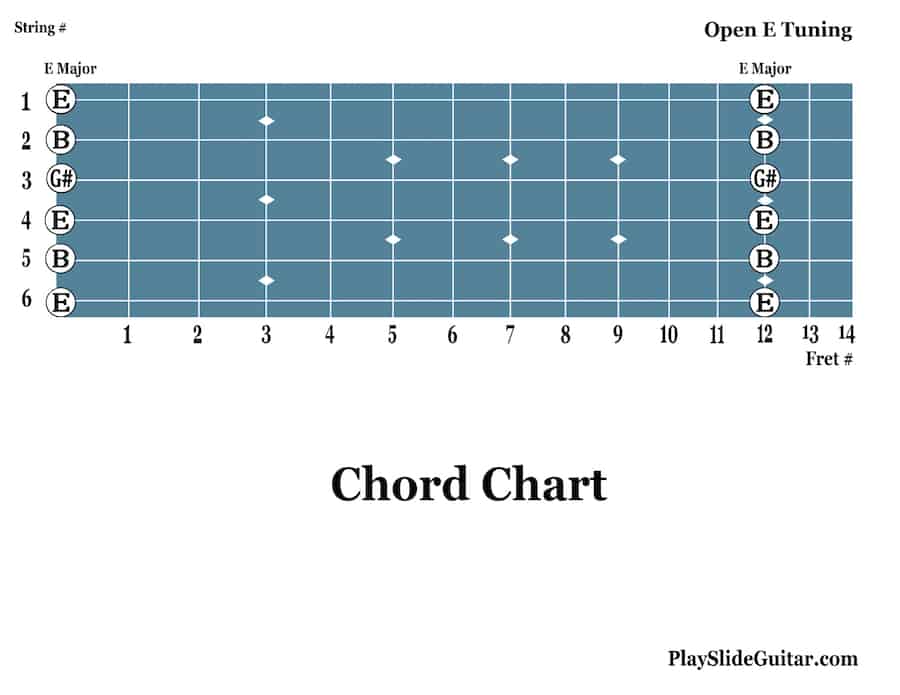
A Major Chord (The 4 Chord in the Key of E Major)

B Major Chord (The 5 Chord in the Key of E Major)

Creating Minor Chords
Minor chords can present more of a challenge on the open E tuning, since the tuning is so relevant to a major chord. However, many minor chords are still present within the tuning, it will just take a little more creativity and ingenuity to use your slide to voice them.
Many major chords can actually substitute as a minor chord, and thus we can use this strategy to find comfortable positions and ways of playing minor chords. For example, the G major chord is great to play over an E minor chord, thus the 3rd fret is a great option for playing either chord.
With minor chords on the open E tuning, when you are using your slide to voice notes you won’t always have the flexibility of fretting notes with your fingers to create minor chord shapes. Oftentimes with the slide, it will become more challenging to voice the full harmonic options of a minor chord at once, and you may have to omit the root note or minor third of the chord.
If you are playing along with a bass player, or other harmonic instrument, then your minor chord voicings will still retain a lot of their perceived minor tonalities. However, keep in mind that if you are playing slide guitar without accompaniment, making your minor chords sound minor may become more challenging if you are only using bits and pieces of the minor chord, which is sometimes all you have available due to the tuning’s foundation around the major chord.
This can be remedied by voicing a minor third in the melody occasionally, or hinting at the harmonic elements of a minor chord in other aspects of your playing.
Here are some minor chord options for the open E tuning, that are also in the key of E major (these also display the number system if you’d like to relate the chords to each other in the key of E major):
F# Minor Chords (The 2m Chord in the Key of E Major)
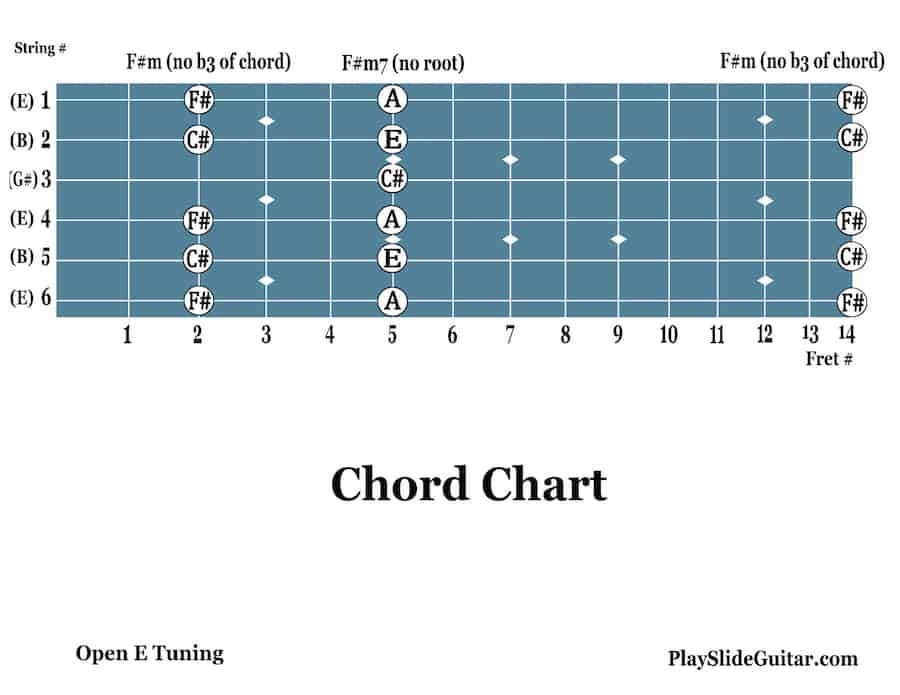
G# Minor Chords (The 3m Chord in the Key of E Major)
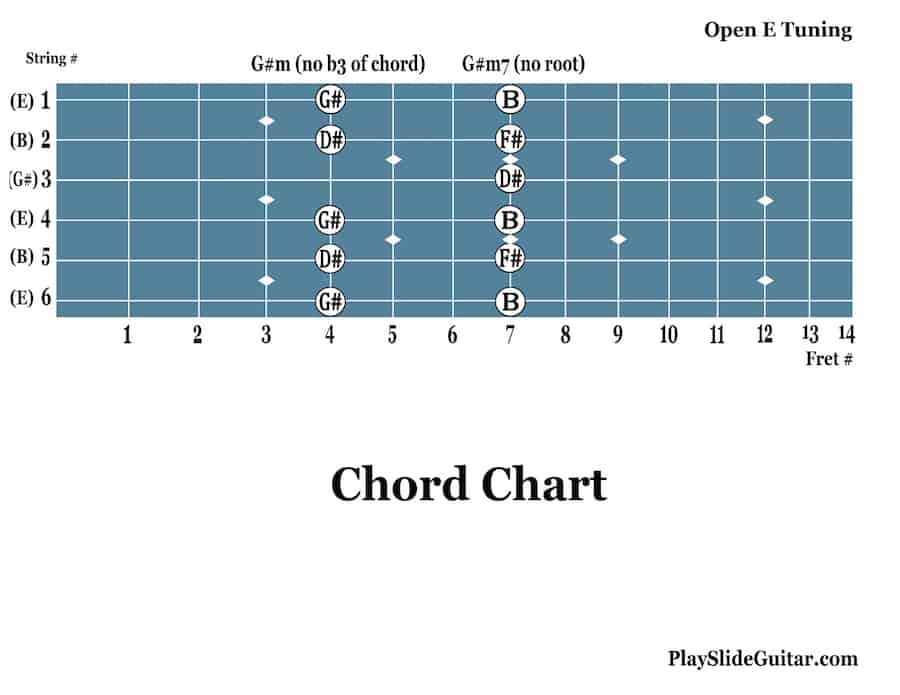
C# Minor Chords (The 6m Chord in the Key of E Major)
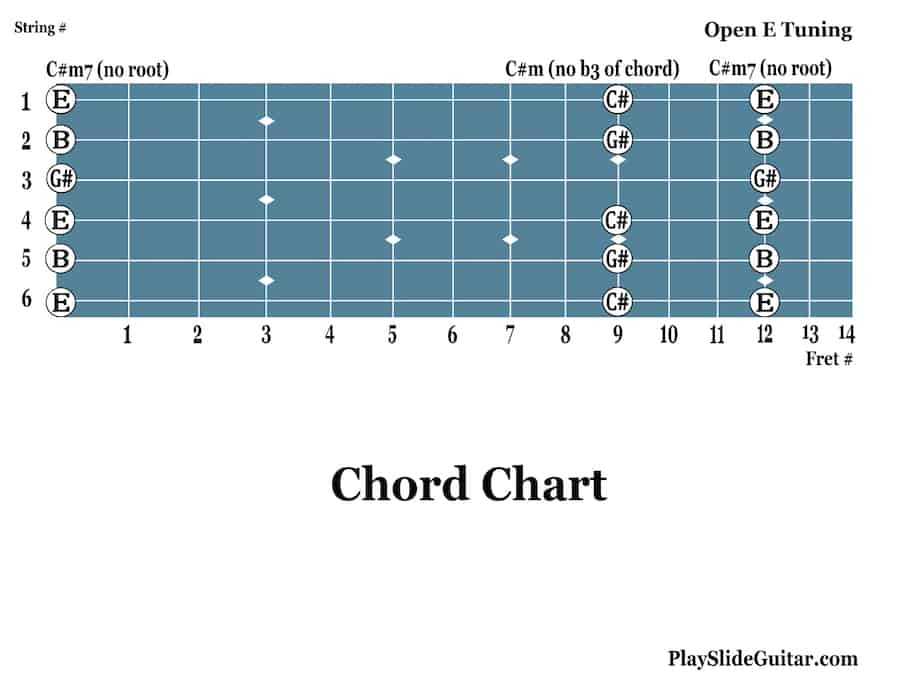
Using This Tuning On Your Instrument
The open E tuning is so close to the standard E tuning of guitars that it may seem that tuning your standard guitar to this tuning is just a matter of re-tuning some of the strings: however, this may damage your guitar (especially if you’re using an acoustic) and it is usually best to have your guitar setup by a professional luthier or repairman if you want to utilize the open E tuning.
Strings 5 through 3 will require a greater amount of tension than a standard guitar tuning, and when you get your guitar setup, they will likely adjust the string gauges, nut, bridge, and truss rod of the guitar to accommodate the tuning for your guitar. Also, you will want to think about the type of action you’d like and how high the strings are above the fretboard.
Conclusion
The open E tuning has a vibrancy and tonality to it that is great for slide guitar. Listening to Duane Allman’s licks and solos on The Fillmore East album are a great way to appreciate the tuning’s use, as well as listening to almost anything that Derek Trucks has recorded.
Whether you’re paving new paths with the tuning, or learning classic songs and riffs from previous players (or doing both!), the open E tuning is a great way to dive deeper into the art of slide guitar.
For open E tuning scale diagrams and tabs, click below…
